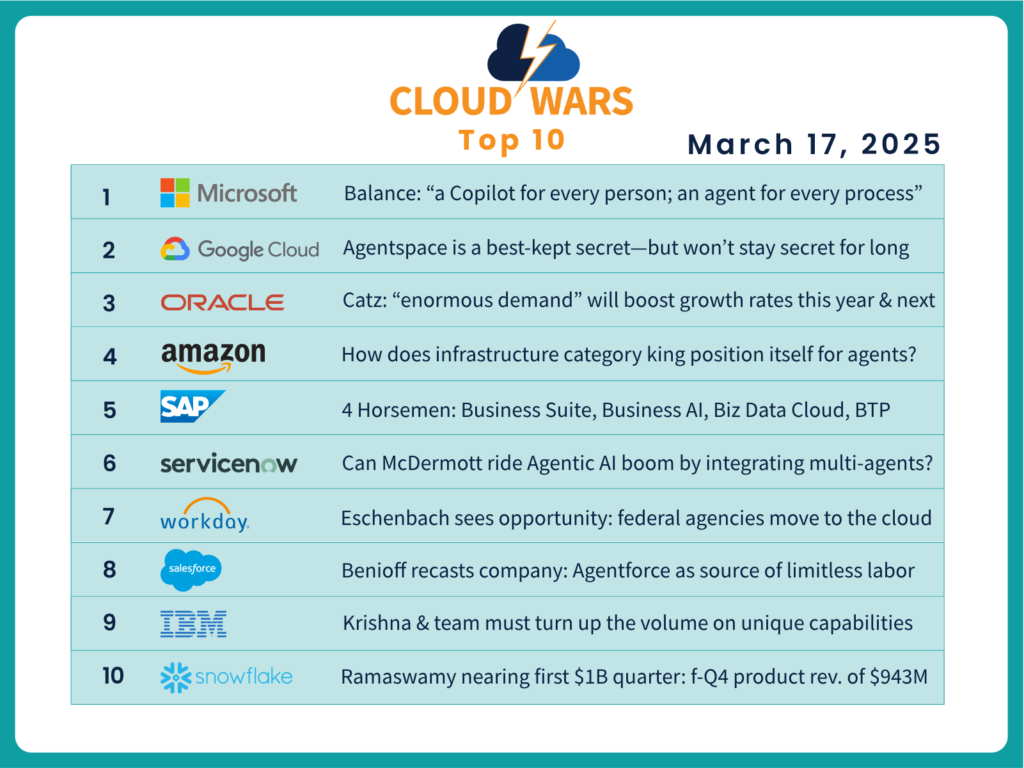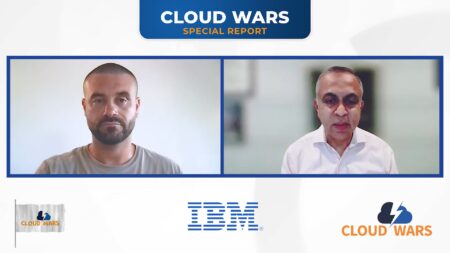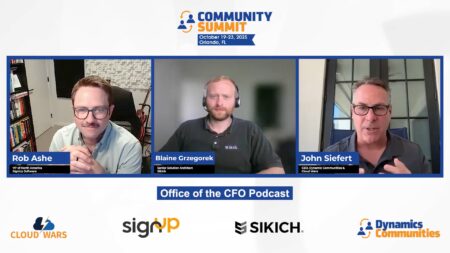
Oracle’s stunning success in winning significant cloud-infrastructure market share from three of the world’s most-powerful corporations is the fruit of technology innovation, go-to-market innovation, strategic differentiation, and an absolute refusal to play by the rules established by the incumbents.
That surging market momentum was quantified in stark detail last week as Oracle reported its total RPO jumped 63% to $130 billion in Q3 ended Feb. 28. One other related detail from Q3: In the quarter, Oracle signed customer contracts that contributed a whopping $48 billion to that RPO total.
And as the AI Revolution morphs from shiny-object phenomenon to a worldwide business imperative, I’d like to showcase 10 core factors behind that extraordinary achievement by Oracle, which achieved those stratospheric growth figures in spite of competing directly against global powerhouses Microsoft, Google, and Amazon.
I’ve extracted my 10 reasons for the RPO surge from commentary from Oracle CEO Safra Catz and chairman/CTO Larry Ellison on last week’s fiscal-Q3 earnings call. You can check out my top-line analyses of key financial details from that call here:
- WATCH: Oracle Q3 OMG! RPO +63% to $130B; DB Multicloud +92% Q/Q
- Oracle Q3 RPO Soars 63% to $130 Billion, Proof of Enormous Pipeline
As you peruse these 10 factors, keep in mind that while advanced-technology vision and innovation was indispensable for Oracle — and is always so within every company in the Cloud Wars Top 10 —that 63% boom in RPO is also the result of some unprecedented new approaches to multi-cloud partnerships as well as an unflagging aversion to following the crowd.
1. Differentiated architecture enables new deployment/delivery models
Oracle’s Gen2 architecture allows its cloud infrastructure to go big, go very small, sit in Oracle data centers, and/or sit in customer data centers in whatever configuration the customer wants. Is this a technology feature or a go-to-market feature? In today’s blindingly fast and turbulent world, the answer is “yes.”
2. Differentiated architecture enables superior performance and/or cost
Asked to explain Oracle’s big momentum in a savagely competitive market, Ellison said in part, “Well, I think it’s actually very simple. The capability we have is to build these huge AI clusters with technology that actually runs faster and more economically than our competitors. So it really is a technology advantage we have over them. If you run faster and you pay by the hour, you cost less. So that technology advantage translates to an economic advantage, which allows us to win a lot of these huge deals.”
3. Data-center proliferation
“Speaking of data centers, we marked a milestone this quarter as we crossed into triple digits with our 101st cloud region coming online,” Catz said in her prepared remarks on the March 10 call. Warming to the subject, the Oracle CEO demonstrated her company’s sharp strategic differentiation from that of the other hyperscalers by offering this perspective: “It’s just a matter of time before we have more cloud regions than all of our competitors combined, reflecting the strategic advantage of our Gen2 architecture, which offers our customers the most flexibility from a delivery standpoint.”
4. Oracle offers both the largest and the smallest cloud data centers
“We can start our data centers smaller than our competitors, and then we grow based on demand. Building these data centers is expensive, and they’re really expensive if they’re not full or they’re not at least half full. So we tend to start small and then add capacity as demand arises. And that allows us to have higher utilization,” Ellison said. “And the fact that we have a high degree of automation, which lowers our labor costs dramatically. By the way, more important than lowering our labor costs is that with no labor, there’s no human error, there’s no human mischief. So we’re much more reliable and much more secure because we don’t have a lot of human beings in our data centers.”
5. AI segment of infrastructure business growing extremely fast
Ellison offered a compelling perspective on the scale of AI training and of AI inferencing, and on why he believes the latter will be of enormous importance to Oracle’s customers. “It wasn’t just AI training that drove the RPO up — it’s also AI inferencing, and the potential of AI inferencing,” Ellison said. “Think about all of the Oracle databases out there and the data in those databases that are going to train AI models. Those AI models are only useful if they’re familiar with the data that’s your data. The AI models have to understand your products, your customers, your service requests, your financials. So you have to make all that data available to the AI models in those databases. This has not been possible, and we’re right at the beginning of that.” A few moments later, Ellison expanded on the value that AI inferencing offers to customers: “There are literally millions of Oracle Databases all over the world and all of those millions of databases and all of that data will be used to train AI models. And, and on top of that, they’ll build agents and applications…. There are hundreds of thousands of our customers that will be consuming those AI models and training those same AI models on their private data. And then running agents and applications on top of all of that. That’s a much bigger market than AI training for us.”
6. Oracle’s breakthrough multi-cloud agreements with Microsoft, Google Cloud, and AWS
As I’ve stated a number of times in this past, I believe Ellison’s ability to forge these agreements through which his three primary competitors — the original three giant hyperscalers — can in effect sell and support the Oracle Database must be regarded as one of Ellison’s most-legendary achievements. On the earnings call, both Catz and Ellison were unreservedly bullish on the latest financial results for the multi-cloud database business as well as its future prospects. “That revenue is more than 10X what it was just a year ago, and the numbers are exploding. As I told you, we’ve got 18 live, but 40 more coming online. So that is going unbelievably well.” Later in the call, Catz offered a deeper insight into the competitive dynamics among the three original hyperscalers that will benefit not only customers, but also Oracle. “Everyone’s motivated to get [the new multi-cloud regions] up as quickly as possible because as you know, the way the revenue flows through is that it flows through to our partner or our host and then they pay us.
“So they’re very, very motivated to get it as quickly as possible because that is holding up revenue for them until they can deploy it…. As you can imagine, there’s some significant competition between those three hyperscalers to grab those workloads before their competitors take them….
“When those customers move, they often bring a lot of additional workloads connected to the database into that hyperscaler’s cloud, and often directly into OCI because of course we are the fourth hyperscaler so we’re a competitor for them.”
7. OCI customers are committing to bigger and longer-term contracts
Oracle’s booming RPO backlog, Catz said, “reflects the growing trend of customers wanting larger and longer contracts as they see firsthand how Oracle Cloud Services are benefiting their businesses further. Our cloud RPO grew over 90% and now represents more than 80% of total RPO, and approximately 31% of that total RPO number is expected to be recognized as revenue over the next 12 months.”
8. The AI Revolution will take no prisoners — and demand is exploding
Business leaders realize they don’t have a handful of years to sit on the sideline and monitor what others are doing before forming a committee to spend 18 months brainstorming — that’s all a recipe for unmitigated disaster. So with lots of tech vendors eagerly touting their AI expertise, Oracle — for reasons outlined above and below — is winning the hearts, minds, and wallets of a rapidly escalating number of customers. “Growth in the AI segment of our infrastructure business was extraordinary,” Catz said. And wrap your head around her framing of Oracle’s aggressive buildout of data centers: “The growth of our power capacity under contract is even higher than the growth in the number of data centers, and we expect that our available power capacity will double this calendar year. And triple by the end of next fiscal year.” Turning back to revenue, Catz explained that as those huge RPO numbers begin to convert to revenue, the cloud business will sharply lift the growth rate of the entire company for the next few years. “We now have a clear line of sight to our future revenue growth,” Catz said, “and we remain very confident and committed to total cloud infrastructure revenue for fiscal year 2025 growing faster than the 50% reported last year, and it will be even faster for fiscal year 2026 — likely a lot faster. Our confidence in meeting our $66 billion revenue target for FY26 is now stronger than ever, and represents around a 15% growth rate [companywide, not just for cloud]. And more importantly, I now expect that our [companywide] FY27 growth rate will be around 20%, which is even higher than I previously guided.”
9. Customers accelerate migrations of Oracle Database to the cloud
“Customers can get our database everywhere: They can install an Oracle Cloud region on their premises, they can get Oracle Database from Azure, they can get Oracle Database from Google, they can get Oracle Database from AWS,” Ellison said on the call. “And that Oracle Database is becoming more and more capable. It already stores most of the world’s most-valuable data and has by far the largest database installed base in the world, with nothing remotely close. And most of those databases are still on premise, but now they’re beginning to migrate to the cloud. And one of the big drivers of them migrating to the cloud is the Autonomous version of the database.
“And now perhaps just as importantly we’ve introduced the AI Data Platform, which allows you to take all of your existing data and make it available to any of the leading AI models — xAI Grok, ChatGPT, Llama. All of them can immediately take advantage of your existing data and your existing database and turn it into insights and actions and agents, acting directly on your private data while keeping that private data private. And that has been the missing link for companies and government agencies.”
10. Larry Ellison’s vision
Examples of Ellison’s ability to see the future and then create it are legion: the acquisition of Sun 16 years ago which gave Oracle the hardware expertise that has become an indispensable foundation for its entire cloud-infrastructure business; the Autonomous Database; the willingness to go head-on against Microsoft, Google Cloud, and AWS; Cloud@Customer; Dedicated Cloud Regions; being willing and able to conceive and build the world’s largest as well as smallest cloud data centers; and, among many others, the remarkable multi-cloud Database partnerships (with primary competitors!) outlined above in #6.
In times like these, which for business leaders are both wildly exhilarating and also fairly dangerous, the vision and track record of Larry Ellison can be a compelling factor in deciding which strategic cloud partner to run with into the AI Revolution.










